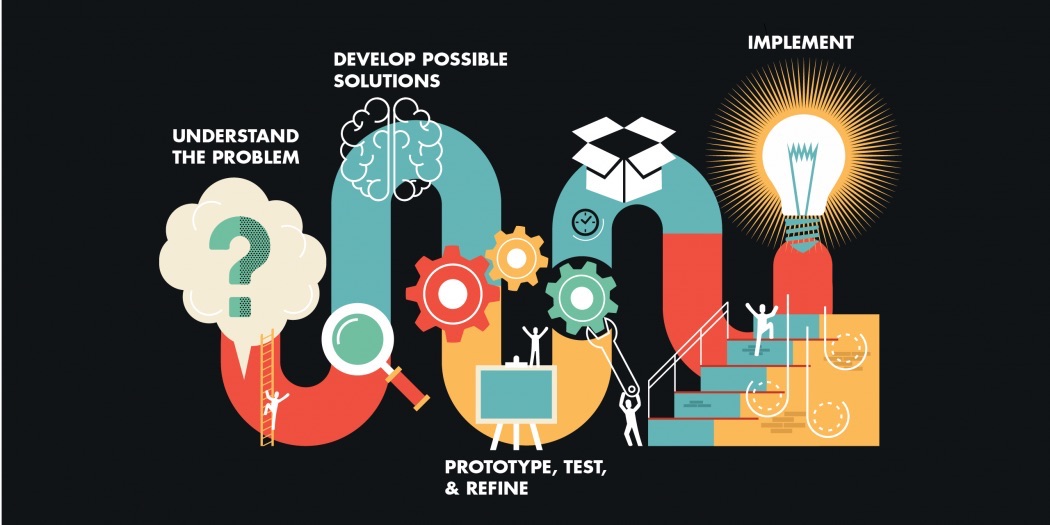How small businesses can use “design thinking” to improve crucial processes
Editorial Team
5 min read
Small business owners are often so busy, they may not have time to step back and observe their own patterns. What many small merchants don’t realize is that some of the same problems keep cropping up over and over again. This can boil down to a specific glitch where a simple shift in thinking could be the solution.
Enter: design thinking. Design thinking is a fresh approach that can help small businesses reevaluate how their habits and patterns may be that stealing their time and inhibiting growth. Big companies like Apple and AirBnB use design thinking to fuel their growth and innovation. For small businesses, this could be the secret to thinking outside the box and inspiring your business to grow to new heights.
What is design thinking?
Design thinking is a method of problem solving that focuses on humans. This particular approach seeks to understand a person’s needs, and then brainstorm solutions to meet those needs. Another way to describe design thinking is to call it a solution-based approach to problem-solving.
How does it work in practice? For small business owners, design thinking simply means applying the iterative process of designing products or services to more complex business operations or systems. There are five high-level steps to using design thinking.
- Empathize
- Define the problem
- Explore all possible solutions
- Iterate through testing
- Implement a solution

First: empathy. This step is all about setting aside your assumptions and getting in the mind of the consumer. Put yourself squarely in the customer journey: when a customer leaves your store without making a purchase, or behaves a certain way in relation to your business, what could be some of the reasons behind that behavior?
Take time to understand the problem—and make sure the problem you think that you’re solving is really the one you need to address. Identifying the hidden need of the customer is the first step to identifying a solution. Make sure you spend time speaking to some of your customers or employees to really align on what the core issue is.
Next, explore all possible solutions. Do some brainstorming to come up with some ideas that you might not normally consider. During this phase, there’s no idea too crazy: the purpose and goal is to think as far out of the box as possible.
Once you have as many solution-based ideas down as possible, go back to your list to identify the best, most feasible solutions for iteration. Iteration, or prototyping, is when you and your team test out some ideas to see what has impact. It may be that some of the solutions are still not fully thought out, and that’s ok. Repeat the process of prototyping your solution, testing, and getting user feedback until you know the design is right. Only through repeated testing will you be sure you have the right possible path forward.
Implementation is the stage in which business owners spend the most time, money, and energy. However, if you followed the rest of the steps correctly, this is also the phase where you will start to see business results impact your bottom line. Congratulations!
How can small business owners use design thinking?
If all of this feels somewhat academic, it can actually have a big impact on how your team works. One of the big advantages of design thinking is that it helps businesses of all sizes break out of unproductive cycles and “business as usual” ways of thinking. Here are a few examples of where you might use design-based thinking in your small business.
Morale is low in a restaurant’s kitchen. The restaurant owner assumes this is related to hourly wages or benefits—two expenses he can’t afford to increase at the moment. However, the business owner uses design thinking and conducts interviews with the kitchen staff. He works a few shifts and realizes that morale is low in part because employees prepare the same dishes over and over, and in part because their uniforms are itchy and uncomfortable. The solution? New uniforms.
A coffee shop wants to build a lunch business after the AM rush. The coffee shop owner isn’t sure if this is a good idea or not; so, she puts herself in the shoes of the customer. She walks outside to see how close it would be for other working professionals to walk over for lunch. She does a sweep of the neighborhood to see what other cafes are offering on their menus, and what their price points are. When it’s clear that the closest offices are at least a drive away, she comes up with the idea of selling pre-packed lunches. Now, customers can pick up lunch with their morning coffee.
A retailer sees a lot of foot traffic that doesn’t result in sales. A retailer runs an online promo inviting people to take advantage of certain deals when they come by the store This generates a lot of foot traffic, but doesn’t result in a sales bump. He assumes this has to do with the deal itself, before following the customer journey. Then, the business owner realizes his store layout is making it difficult for a new customer to find the product offered in the deal. By making some changes to the front-of-house, the business owner capitalizes on the online to offline conversion.
Related Posts
The definitive guide to handling product & inventory
Top podcasts for small business owners and entrepreneurs
Popular Topics
Stay In Touch
Sign up and learn more about Clover.
Thank you for your subscription!
Recent Stories
- Jewelry store supplies and equipment needed for opening day
- How small businesses can use employee discounts to retain staff
- Tips and tricks for opening an outdoor pop-up restaurant
Please share your contact information
to access our premium content.
Thank you for sharing your contact information.
Download Now





